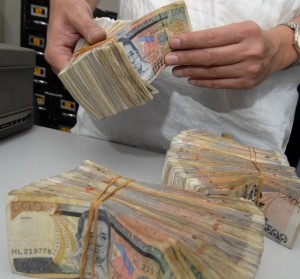
A bank teller prepares stacks of P500 denomination for the bank’s automated cash dispenser in this file photo. Although, bank lending rates have dropped, the Philippine central bank wants banks to offer even cheaper loans. AFP
Bank lending rates may have dropped by an average of 35.5 basis points since the start of the year, but the Bangko Sentral ng Pilipinas still wants the banking sector to offer even cheaper loans.
Because the BSP has cut its key policy rates by a total of 50 basis points this year, monetary authorities expect bank lending rates to be reduced by an amount equivalent to that of the government so that the desired impact on the economy will be achieved.
The BSP’s monetary policy is meant to influence commercial interest rates being charged to borrowers.
“Currently, there is a 75-percent pass-through of the rate cuts done by the BSP,” BSP Deputy Governor Diwa Guinigundo said, adding that banks are expected to fully absorb the cut in key rates.
The moves of the BSP to reduce its monetary policy in January and in March were meant to boost demand for bank loans which, in turn, could spur consumption and investments.
Monetary officials said bank lending, which grew by a robust pace last year, should rise further to accelerate growth of the economy.
The economy, measured in terms of gross domestic product, grew by 3.7 percent last year, slowing down from the 7.6 percent pace registered in 2010. Weak export earnings due to declining demand from crisis-stricken economies in Europe contributed much to the slowdown.
With bank lending expected to grow further, domestic spending may increase and offset the ill effects of sluggish exports on the economy, officials said.
Latest lending data from the BSP showed that outstanding loans of universal and commercial banks grew by 18 percent to P2.76 trillion as of end-February from the P2.34 trillion reported in the same period last year.
According to the BSP, banks need to sustain robust growth in lending since they have the capacity to offer more loans given their significant resources.
It noted that bank deposits, which banks use for lending, have been growing at a healthy pace.
During a meeting of the central bank’s Monetary Board on Thursday, officials kept the overnight borrowing and lending rates at 4 and 6 percent, respectively—the lowest setting ever.
The BSP said the move last Thursday should enable banks to fully absorb the 50-basis-point reduction in key policy rates made earlier in the year.
Also, the central bank said the key rate setting was meant to avoid any acceleration of inflation to levels beyond the ceiling set.
The BSP cited rising oil prices as some of the price pressures that could cause inflation to accelerate.
Since the cut in interest rates spur demand for loans, triggering purchases of goods and services in turn, this move may speed up inflation. If there are price pressures like rising cost of oil, interest rates must not be set too low to temper inflation.
The BSP said that the existing policy rates are considered to be just right—it pushes up demand at levels that will not cause inflation to breach the targeted ceiling set between 3 and 5 percent.
In the first quarter, inflation averaged at 3.1 percent.

